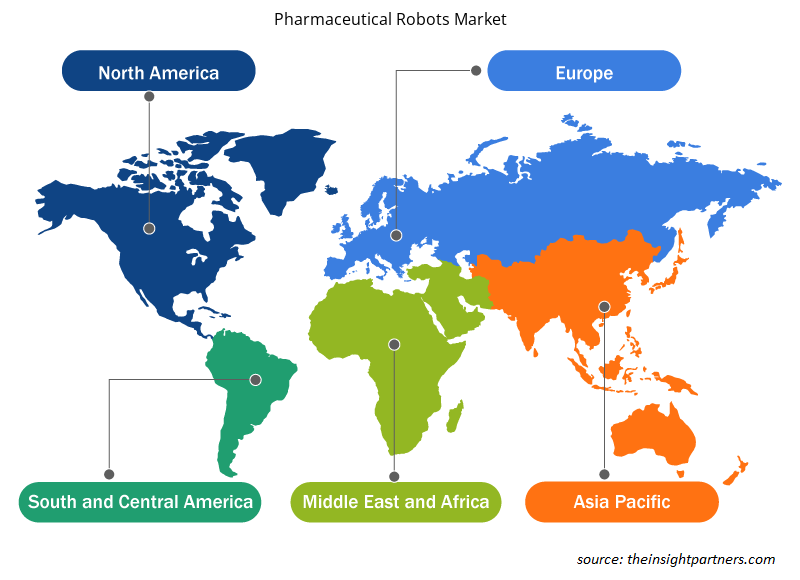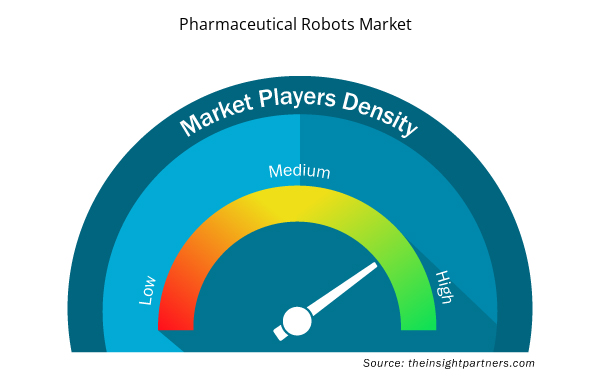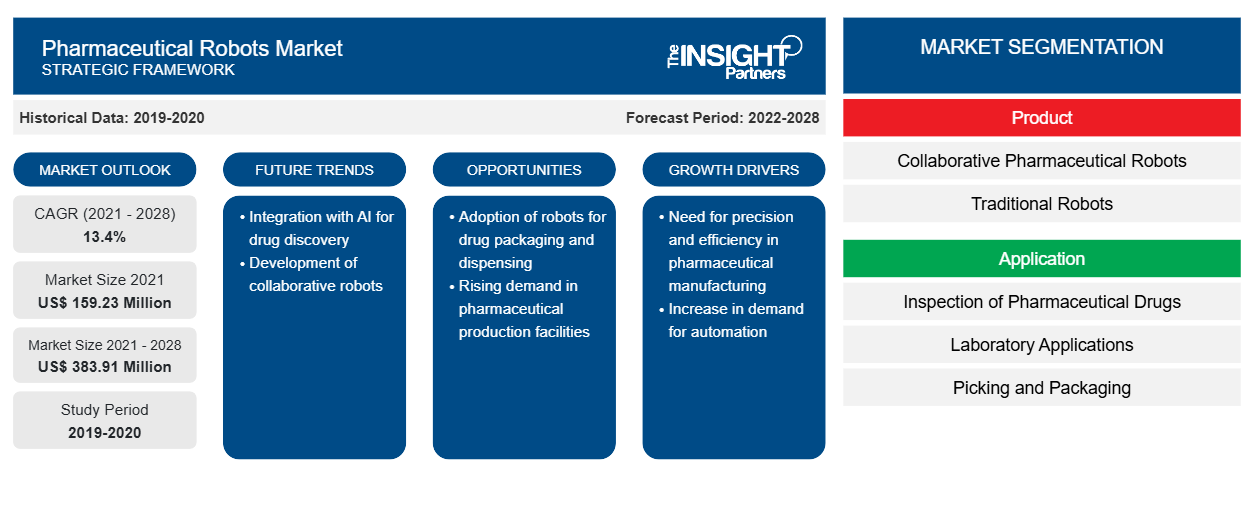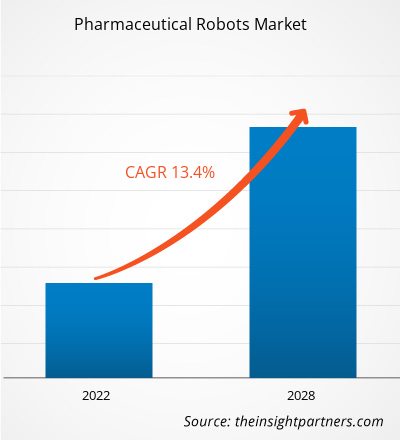[تقرير بحثي] من المتوقع أن يصل سوق الروبوتات الصيدلانية إلى 383.91 مليون دولار أمريكي بحلول عام 2028 من 159.23 مليون دولار أمريكي في عام 2021؛ ومن المتوقع أن ينمو بمعدل نمو سنوي مركب قدره 13.4٪ من عام 2021 إلى عام 2028.
تتطلب صناعة الأدوية دقة وكفاءة في إنتاج الأدوية الصيدلانية. وبالتالي، فإن استخدام الروبوتات في تصنيع الأدوية يحسن الجودة ويقلل التكلفة والوقت. أثبتت الروبوتات أنها مفيدة في التعبئة والتفتيش والتعبئة والمختبرات وتصنيع الأدوية المخصصة. النظام الروبوتي هو نوع من الأتمتة التي تحتوي على محاور حركة متعددة ويمكن برمجتها لأداء أي وظيفة.
يقدم التقرير رؤى وتحليلات متعمقة لسوق الروبوتات الصيدلانية مع التركيز على معايير مختلفة مثل اتجاهات السوق والتقدم التكنولوجي وديناميكيات السوق وتحليل المشهد التنافسي للاعبين الرئيسيين في السوق في جميع أنحاء العالم. كما يتضمن تأثير جائحة COVID-19 على السوق في جميع المناطق. كما أضر تأثير الوباء وانخفاض أنشطة البحث العالمية بعمليات وتنفيذ العديد من الشركات في سوق الروبوتات الصيدلانية. تساعد المنظمة العالمية لصحة الحيوان (OIE) في إجراء البحوث من أجل أبحاثهم الجارية والآثار الأخرى لـ COVID-19 على صحة الحيوان والصحة العامة للدواجن. تساعد المنظمة أيضًا في تقييم المخاطر وإدارتها وتواصل المخاطر. نشرت المنظمة العالمية لصحة الحيوان نظام تنسيق الحوادث لتنسيق هذه الأنشطة. علاوة على ذلك، أثرت جائحة COVID-19 وفرض الإغلاق الناتج عنها بشكل كبير على قطاعي الثروة الحيوانية والدواجن في بلدان مختلفة في العالم. وجد أن فجوة العرض والطلب تتناقص تدريجيًا مع فتح سلاسل السوق والخطوات الإضافية التي اتخذتها الإدارات المحلية في سد الاختناقات في أنظمة التوصيل. ومن المتوقع أيضًا أن يستمر التأثير طويل الأمد وسيكون له تأثير كبير على سبل العيش والتوظيف والاقتصاد العام للقطاع. يتم تقسيم سوق الروبوتات الصيدلانية على أساس الجرعة والمرض والتكنولوجيا والمنطقة. يتم تقسيم السوق، بناءً على المنطقة، إلى أمريكا الشمالية وأوروبا وآسيا والمحيط الهادئ والشرق الأوسط وأفريقيا وأمريكا الجنوبية والوسطى.
رؤى السوق
قم بتخصيص هذا التقرير ليناسب متطلباتك
ستحصل على تخصيص لأي تقرير - مجانًا - بما في ذلك أجزاء من هذا التقرير، أو تحليل على مستوى الدولة، وحزمة بيانات Excel، بالإضافة إلى الاستفادة من العروض والخصومات الرائعة للشركات الناشئة والجامعات
- احصل على أهم اتجاهات السوق الرئيسية لهذا التقرير.ستتضمن هذه العينة المجانية تحليلاً للبيانات، بدءًا من اتجاهات السوق وحتى التقديرات والتوقعات.
الاتجاه الصاعد للروبوتات السحابية
الروبوتات السحابية هي مجال ناشئ في مجال الروبوتات متجذر في الحوسبة السحابية والتخزين السحابي وتقنيات الإنترنت الأخرى التي تركز على فوائد البنية الأساسية المتقاربة والخدمات المشتركة. يؤدي ربط الروبوتات بالسحابة إلى زيادة القدرة الحسابية والتخزين والاتصالات. تتواصل الروبوتات السحابية مع بعضها البعض وبالتالي يتم تنفيذ العمليات بسهولة.
تجمع منصة Google Cloud Robotics بين الذكاء الاصطناعي والروبوتات والسحابة لتمكين فتح نظام بيئي لحلول الأتمتة التي تستخدم الروبوتات التعاونية المتصلة بالسحابة. جنبًا إلى جنب مع خدمات الذكاء الاصطناعي والتعلم الآلي، ستكون الروبوتات قادرة على تنفيذ العمليات بكفاءة في بيئات شديدة الديناميكية في صناعة التصنيع. علاوة على ذلك، في الصناعة، تعد السحابة حليفًا لمعالجة كمية كبيرة من البيانات. على سبيل المثال، أعلنت شركة Exscientia وشركة Celgene للأدوية الحيوية عن صفقة بقيمة 19.64 مليون يورو في عام 2019 لتسريع اكتشاف أدوية السرطان وأمراض المناعة الذاتية. في عام 2020، أعلنت أيضًا عن تعاون مع شركات أخرى للعثور على أدوية محتملة لـ COVID-19. ونتيجة لذلك، تتمتع الشركة الآن بالوصول إلى مجموعة من الجزيئات، بما في ذلك الأدوية والمواد الكيميائية الأخرى، التي تم اختبارها بنجاح على البشر. كانت الشركة تنوي مسح القائمة بحثًا عن أي أدوية يمكن أن تكون قادرة على مكافحة الفيروس. وتقوم تقنية إكسينتيا بمسح قواعد البيانات الضخمة ويمكنها التنبؤ بدقة بالمركبات التي لا تسبب آثارًا جانبية للوصول إلى الهدف المطلوب. وعلى نحو مماثل، في عام 2020، دخلت شركة أدوية أخرى، وهي بوهرينغر إنجلهايم، في شراكة مع شركة للتكنولوجيا الحيوية، كليك ثيرابيوتكس، لإنتاج 500 مليون دولار من العلاجات الرقمية. وبشكل أكثر دقة، خططت الشركتان للتعاون في تطوير وتوزيع تطبيق جوال لمساعدة مرضى الفصام الذين يعانون من قصور إدراكي. كما أنشأت آي بي إم RoboRXN، وهو مختبر كيميائي يستخدم الذكاء الاصطناعي والحوسبة السحابية والروبوتات لتطوير الأدوية من منازل الباحثين.
يمكن اعتماد البرمجيات المستندة إلى السحابة، مع بروتوكولات الأمان المناسبة، لتسهيل التكامل والأتمتة. يساعد استخدامها في تقليل الأعمال الورقية للشركات، مما يجعل البيانات قابلة للإدارة. وبالتالي، من المتوقع أن تصبح الروبوتات السحابية الاتجاه السائد في سوق الروبوتات الصيدلانية في المستقبل.
رؤى قائمة على المنتج
بناءً على المنتج، يتم تقسيم سوق الروبوتات الصيدلانية إلى روبوتات صيدلانية تعاونية والروبوتات التقليدية. في عام 2021، من المتوقع أن يشكل قطاع الروبوتات الصيدلانية التعاونية أكبر حصة في السوق، في حين من المتوقع أن تشهد الروبوتات التقليدية أعلى معدل نمو سنوي مركب في السوق خلال فترة التوقعات. ويعزى نمو هذا القطاع إلى زيادة استخدام الروبوتات في التوزيع والفرز وتجميع الأدوات والعناية بالآلات الخفيفة بالإضافة إلى التطبيقات الأكثر تقليدية المرتبطة بالتعبئة والتغليف وغيرها.
رؤى قائمة على التطبيق
بناءً على التطبيق، يتم تقسيم سوق الروبوتات الصيدلانية إلى فحص الأدوية الصيدلانية، وتطبيقات المختبرات، والاختيار والتعبئة والتغليف. من المتوقع أن يستحوذ قطاع فحص الأدوية الصيدلانية على أكبر حصة من السوق في عام 2021 ومن المتوقع أن يسجل أعلى معدل نمو سنوي مركب في السوق خلال الفترة المتوقعة.
رؤى تعتمد على المستخدم النهائي
بناءً على المستخدم النهائي، يتم تقسيم سوق الروبوتات الصيدلانية إلى شركات الأدوية ومختبرات الأبحاث ومنظمات الأبحاث التعاقدية. من المتوقع أن تستحوذ شريحة شركات الأدوية على أكبر حصة من السوق في عام 2021، في حين من المتوقع أن تسجل شريحة مختبرات الأبحاث أعلى معدل نمو سنوي مركب في السوق خلال فترة التوقعات
يتبنى اللاعبون في سوق الروبوتات الصيدلانية استراتيجيات عضوية مثل إطلاق المنتج وتوسيعه لتوسيع نطاق وجودهم ومحفظة منتجاتهم في جميع أنحاء العالم بالإضافة إلى تلبية الطلب المتزايد.
رؤى إقليمية حول سوق الروبوتات الصيدلانية
لقد قام المحللون في Insight Partners بشرح الاتجاهات والعوامل الإقليمية المؤثرة على سوق الروبوتات الصيدلانية طوال فترة التوقعات بشكل شامل. يناقش هذا القسم أيضًا قطاعات سوق الروبوتات الصيدلانية والجغرافيا في جميع أنحاء أمريكا الشمالية وأوروبا ومنطقة آسيا والمحيط الهادئ والشرق الأوسط وأفريقيا وأمريكا الجنوبية والوسطى.

- احصل على البيانات الإقليمية المحددة لسوق الروبوتات الصيدلانية
نطاق تقرير سوق الروبوتات الصيدلانية
| سمة التقرير | تفاصيل |
|---|---|
| حجم السوق في عام 2021 | 159.23 مليون دولار أمريكي |
| حجم السوق بحلول عام 2028 | 383.91 مليون دولار أمريكي |
| معدل النمو السنوي المركب العالمي (2021 - 2028) | 13.4% |
| البيانات التاريخية | 2019-2020 |
| فترة التنبؤ | 2022-2028 |
| القطاعات المغطاة | حسب المنتج
|
| المناطق والدول المغطاة | أمريكا الشمالية
|
| قادة السوق وملفات تعريف الشركات الرئيسية |
|
كثافة اللاعبين في سوق الروبوتات الصيدلانية: فهم تأثيرها على ديناميكيات الأعمال
يشهد سوق الروبوتات الصيدلانية نموًا سريعًا، مدفوعًا بالطلب المتزايد من المستخدم النهائي بسبب عوامل مثل تفضيلات المستهلكين المتطورة والتقدم التكنولوجي والوعي المتزايد بفوائد المنتج. ومع ارتفاع الطلب، تعمل الشركات على توسيع عروضها والابتكار لتلبية احتياجات المستهلكين والاستفادة من الاتجاهات الناشئة، مما يؤدي إلى زيادة نمو السوق.
تشير كثافة اللاعبين في السوق إلى توزيع الشركات أو المؤسسات العاملة في سوق أو صناعة معينة. وهي تشير إلى عدد المنافسين (اللاعبين في السوق) الموجودين في مساحة سوق معينة نسبة إلى حجمها أو قيمتها السوقية الإجمالية.
الشركات الرئيسية العاملة في سوق الروبوتات الصيدلانية هي:
- شركة أي بي بي المحدودة
- شركة كاواساكي للصناعات الثقيلة المحدودة
- شركة ياسكاوا للكهرباء
- الروبوتات العالمية A/S
- مجموعة ماركيسيني
إخلاء المسؤولية : الشركات المذكورة أعلاه ليست مرتبة بأي ترتيب معين.

- احصل على نظرة عامة على أهم اللاعبين الرئيسيين في سوق الروبوتات الصيدلانية
حسب المنتج
- الروبوتات الصيدلانية التعاونية
- الروبوتات التقليدية
- روبوتات دلتا
- الروبوتات المفصلية
- الروبوتات الديكارتية
- روبوتات سكارا
- آحرون
حسب الطلب
- فحص الأدوية الصيدلانية
- التطبيقات المعملية
- الإختيار والتعبئة والتغليف
حسب المستخدم النهائي
- شركات الأدوية
- مختبرات الأبحاث
- منظمات البحوث التعاقدية
بواسطة
الجغرافيا
أمريكا الشمالية
- نحن
- كندا
- المكسيك
أوروبا
- فرنسا
- ألمانيا
- إيطاليا
- المملكة المتحدة
- إسبانيا
- بقية أوروبا
آسيا والمحيط الهادئ (APAC)
- الصين
- الهند
- كوريا الجنوبية
- اليابان
- أستراليا
- بقية منطقة آسيا والمحيط الهادئ
الشرق الأوسط وأفريقيا
- جنوب أفريقيا
- المملكة العربية السعودية
- الامارات العربية المتحدة
- باقي منطقة الشرق الأوسط وأفريقيا
أمريكا الجنوبية والوسطى (SCAM)
- البرازيل
- الأرجنتين
- بقية الاحتيال
نبذة عن الشركة
- شركة أي بي بي المحدودة
- شركة كاواساكي للصناعات الثقيلة المحدودة
- شركة ياسكاوا للكهرباء
- الروبوتات العالمية A/S
- مجموعة ماركيسيني
- شركة دينسو
- شركة فانوك
- شركة إسبون الهندية المحدودة
- شركة شيبويا
- شركة فايس المحدودة
- التحليل التاريخي (سنتان)، السنة الأساسية، التوقعات (7 سنوات) مع معدل النمو السنوي المركب
- تحليل PEST و SWOT
- حجم السوق والقيمة / الحجم - عالميًا وإقليميًا وقطريًا
- الصناعة والمنافسة
- مجموعة بيانات Excel



Report Coverage
Revenue forecast, Company Analysis, Industry landscape, Growth factors, and Trends

Segment Covered
This text is related
to segments covered.

Regional Scope
North America, Europe, Asia Pacific, Middle East & Africa, South & Central America

Country Scope
This text is related
to country scope.
الأسئلة الشائعة
The growth of the market is attributed to benefits offered by robots in pharmaceutical manufacturing, growing awareness of robotic systems in manufacturing process, increasing investments in pharmaceutical research and development. However, the high cost of robots and dearth of skilled professional hinder the market growth.
The types of pharmaceutical robots are collaborative pharmaceutical robots, and traditional robots. The traditional robots are segmented into delta robots, articulated robots, cartesian robots, scara robots, and others.
Pharmaceutical industry requires efficient and precise precision in production of pharmaceutical drugs. Thus, using robots in pharmaceutical manufacturing improves quality and reduces cost and time. Robots are proving advantageous in filling, inspection, packaging, laboratories, and the manufacture of personalized medicine. A robotic system is a type of automation that has multiple axes of motion and can be programmed to perform any function.Pharmaceutical industry requires efficient and precise precision in production of pharmaceutical drugs. Thus, using robots in pharmaceutical manufacturing improves quality and reduces cost and time. Robots are proving advantageous in filling, inspection, packaging, laboratories, and the manufacture of personalized medicine. A robotic system is a type of automation that has multiple axes of motion and can be programmed to perform any function.
The List of Companies - Pharmaceutical Robots Market
- ABB Ltd.
- Kawasaki Heavy Industries, Ltd.
- Yaskawa Electric Corporation
- Universal Robots A/S
- Marchesini Group S.p.A
- Denso Corporation
- Fanuc Corporation
- Espon India Pvt. Ltd.
- Shibuya Corporation
- Weiss GmbH
The Insight Partners performs research in 4 major stages: Data Collection & Secondary Research, Primary Research, Data Analysis and Data Triangulation & Final Review.
- Data Collection and Secondary Research:
As a market research and consulting firm operating from a decade, we have published and advised several client across the globe. First step for any study will start with an assessment of currently available data and insights from existing reports. Further, historical and current market information is collected from Investor Presentations, Annual Reports, SEC Filings, etc., and other information related to company’s performance and market positioning are gathered from Paid Databases (Factiva, Hoovers, and Reuters) and various other publications available in public domain.
Several associations trade associates, technical forums, institutes, societies and organization are accessed to gain technical as well as market related insights through their publications such as research papers, blogs and press releases related to the studies are referred to get cues about the market. Further, white papers, journals, magazines, and other news articles published in last 3 years are scrutinized and analyzed to understand the current market trends.
- Primary Research:
The primarily interview analysis comprise of data obtained from industry participants interview and answers to survey questions gathered by in-house primary team.
For primary research, interviews are conducted with industry experts/CEOs/Marketing Managers/VPs/Subject Matter Experts from both demand and supply side to get a 360-degree view of the market. The primary team conducts several interviews based on the complexity of the markets to understand the various market trends and dynamics which makes research more credible and precise.
A typical research interview fulfils the following functions:
- Provides first-hand information on the market size, market trends, growth trends, competitive landscape, and outlook
- Validates and strengthens in-house secondary research findings
- Develops the analysis team’s expertise and market understanding
Primary research involves email interactions and telephone interviews for each market, category, segment, and sub-segment across geographies. The participants who typically take part in such a process include, but are not limited to:
- Industry participants: VPs, business development managers, market intelligence managers and national sales managers
- Outside experts: Valuation experts, research analysts and key opinion leaders specializing in the electronics and semiconductor industry.
Below is the breakup of our primary respondents by company, designation, and region:

Once we receive the confirmation from primary research sources or primary respondents, we finalize the base year market estimation and forecast the data as per the macroeconomic and microeconomic factors assessed during data collection.
- Data Analysis:
Once data is validated through both secondary as well as primary respondents, we finalize the market estimations by hypothesis formulation and factor analysis at regional and country level.
- Macro-Economic Factor Analysis:
We analyse macroeconomic indicators such the gross domestic product (GDP), increase in the demand for goods and services across industries, technological advancement, regional economic growth, governmental policies, the influence of COVID-19, PEST analysis, and other aspects. This analysis aids in setting benchmarks for various nations/regions and approximating market splits. Additionally, the general trend of the aforementioned components aid in determining the market's development possibilities.
- Country Level Data:
Various factors that are especially aligned to the country are taken into account to determine the market size for a certain area and country, including the presence of vendors, such as headquarters and offices, the country's GDP, demand patterns, and industry growth. To comprehend the market dynamics for the nation, a number of growth variables, inhibitors, application areas, and current market trends are researched. The aforementioned elements aid in determining the country's overall market's growth potential.
- Company Profile:
The “Table of Contents” is formulated by listing and analyzing more than 25 - 30 companies operating in the market ecosystem across geographies. However, we profile only 10 companies as a standard practice in our syndicate reports. These 10 companies comprise leading, emerging, and regional players. Nonetheless, our analysis is not restricted to the 10 listed companies, we also analyze other companies present in the market to develop a holistic view and understand the prevailing trends. The “Company Profiles” section in the report covers key facts, business description, products & services, financial information, SWOT analysis, and key developments. The financial information presented is extracted from the annual reports and official documents of the publicly listed companies. Upon collecting the information for the sections of respective companies, we verify them via various primary sources and then compile the data in respective company profiles. The company level information helps us in deriving the base number as well as in forecasting the market size.
- Developing Base Number:
Aggregation of sales statistics (2020-2022) and macro-economic factor, and other secondary and primary research insights are utilized to arrive at base number and related market shares for 2022. The data gaps are identified in this step and relevant market data is analyzed, collected from paid primary interviews or databases. On finalizing the base year market size, forecasts are developed on the basis of macro-economic, industry and market growth factors and company level analysis.
- Data Triangulation and Final Review:
The market findings and base year market size calculations are validated from supply as well as demand side. Demand side validations are based on macro-economic factor analysis and benchmarks for respective regions and countries. In case of supply side validations, revenues of major companies are estimated (in case not available) based on industry benchmark, approximate number of employees, product portfolio, and primary interviews revenues are gathered. Further revenue from target product/service segment is assessed to avoid overshooting of market statistics. In case of heavy deviations between supply and demand side values, all thes steps are repeated to achieve synchronization.
We follow an iterative model, wherein we share our research findings with Subject Matter Experts (SME’s) and Key Opinion Leaders (KOLs) until consensus view of the market is not formulated – this model negates any drastic deviation in the opinions of experts. Only validated and universally acceptable research findings are quoted in our reports.
We have important check points that we use to validate our research findings – which we call – data triangulation, where we validate the information, we generate from secondary sources with primary interviews and then we re-validate with our internal data bases and Subject matter experts. This comprehensive model enables us to deliver high quality, reliable data in shortest possible time.


 احصل على عينة مجانية لهذا التقرير
احصل على عينة مجانية لهذا التقرير